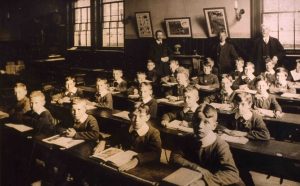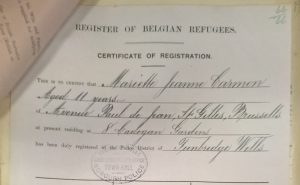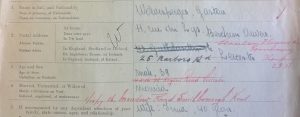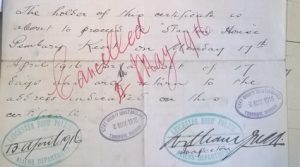In all, 75 Belgian refugee children passed through Tunbridge Wells (though the maximum at any one time was only 35), and arrangements were made with the Borough’s schools to give them free education as required. Some were taught by the Belgian nuns staying at Clayton’s Farm, and most of the younger children attended St Augustine’s Catholic Primary School.

Photo of St Augustine’s Church showing the school building on the right (from John Cunningham)
However, King Charles and Murray House Church of England Schools certainly took in one boy and two girls, the Girls’ High School in Camden Park had one pupil who was being supported by the Old Girls of the school, and a number attended the County School for Girls (now TWGGS). There were boys at Skinners’ School and at Tonbridge School, and girls at the Blessed Sacrament Convent School for Girls and little Boys on Prospect Road, as well as at Mark Cross Convent, and from February 1915 a number of Belgian refugee children attended the newly-opened Sacred Heart Convent School at Beechwood on Pembury Road – in fact the very first pupils to arrive were 7 and 8 year old Clementine and Christiane WILLEMS, 2 of the 6 children of Prof. Joseph WILLEMS from Liege. We think that they could be the two little girls on the right in the front row of this photo :

Beechwood Sacred Heart first school photo (date unknown) – from the school
Consultation of primary school log books in the County Archives in Maidstone only turns up numbers of children – sadly no names – the most tantalising being ‘2 boys from Lubbeck’ (Lubbeek) who were at Down Lane Infants School, Culverden Down, from February 1915, and possibly left in 1916 or ’17 to go to St Augustine’s School. All we found for St Augustine’s School was the Punishment Book, and sadly that is ‘closed’ for another 50 years or so as it covers recent years.

A classroom at King Charles the Martyr Boys School (Tunbridge Well Museum)
One of the school children given free education through the Mayor’s Committee was Mariette CARMON. The Tunbridge Wells Advertiser of 18th May 1917 reported that Mariette had joined Murray House School in October 1914 and that in July 1916, Kent Higher Education Committee “consented that she be educated at the County School in recognition of her good work”.
In July 1916, according to the Kent and Sussex Courier, Murray House School Annual Sports afternoon at the Nevill Ground included the presentation of ‘a charming scene’ from Hiawatha in which Mariette CARMON played Chibiabos, musician and close friend of Hiawatha, and an M. Carmon was awarded a swimming certificate and badge.
The admissions records at Tunbridge Wells Girls Grammar School (TWGGS – formerly the County School) gave us a bit more information about her: at the time of her admission to the County School she was 13 – her father was in Paris, and she was boarding with a Mrs Fry at 4 Ferrars Estate. She returned to Belgium in July 1918. Registration documents found in the Archives in Brussels tell us that she was 11 when she arrived in Tunbridge Wells where she lived first at 8 Cadogan Gardens.

It looks as though she was quite alone during her time here, though she did visit Guildford in the summer of 1918. Her name does not appear in the 1916 album presented to the Misses Scott, even though she was in Tunbridge Wells at the time. I wonder why?
A BELGIAN SCHOOL
Interestingly, only in early 1918 was a Belgian School started up in Tunbridge Wells, and that thanks to Mr Albert LE JEUNE, Honorary President of the Club Albert. Head of the school was Professor Gaston WOLVERSPERGES, a refugee from Antwerp, who with his wife Irma had arrived in Tunbridge Wells from Leicester in August 1917. His registration papers show frequent visits to the LE JEUNE family residence, Stanton House in Pembury, which suggests they were already friends – maybe Mr Le Jeune arranged for him to come to Tunbridge Wells especially to set up the school?
I have found no record of this school in the local Kent press or records, or the existing listings of Belgian school in the UK during the First World War. It was an article in L’Independence belge of 7th August 1918 which alerted me to its existence. It seems that that year the celebrations for Belgian National Day on 21st July had included the school prize-giving and recitations in French and Flemish of poetry and prose by the children. The purpose of the school, the article explained, was to complement the ‘instruction’ the children were already receiving in English schools. Pupil numbers were growing, and the mothers and fathers were very grateful to Professor WOLVERSPERGES for the devotion with which he carried out his difficult task.

Refugee Registration Form – undated but probably 1914/1915 given Prof WOLVERSPERGES’s age
The registration documents I consulted show that Gaston WOLVERSPERGES was born in Schaerbeek, Brussels, on 8th June 1875 and that his home address was 11 rue du Lys, Berchem, Antwerp. A teacher of Geography and History, he spoke both French and Flemish. Once in the Tunbridge Wells area, he and his wife lived first at 16 Meadow Road in Southborough, and later, from February 1918, at 9 Cambridge Street.
He was also employed as a teacher at ‘Lingfield School’- presumably Lingfield Primary School as the Convent School (now Lingfield College) was only founded in 1940.

Extract from the reverse of Mr WOLVERSPERGES’s registration document in the Belgian National Archives showing one of his visits to Stanton House
Sources
Kent Library and Archive Centre, Maidstone C/E/S/371E/17/2 – Down Lane Infants School Log Book 1899 -1942
National Archives, Brussels
Tunbridge Wells Advertiser (on microfilm in Tunbridge Wells Library )
TWGGS Archives (with thanks to Astrid and Hilary Streeter)
Belgian Press in Exile www.hetarchief.be
‘The Leopard’ , Skinners School magazine, for the years 1914-1919
